
x
Contents
Home
Home
Home
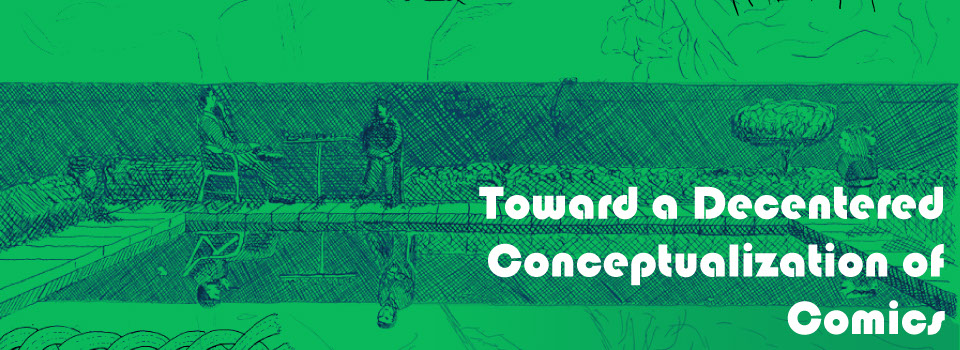
From Defining to Decentering
If all new media blur the lines between modes, why start with comics? One measures a circle starting anywhere (Charles Fort or Alan Moore, I can never remember)* so we might as well start there, at the periphery, in that marginalized medium. However, comics also seem to evidence this multimodality more explicitly than any other medium. Before we continue we should look into the definition or indefinability of comics.
We must start where every scholarly work on comics starts, with Will Eisner and Scott McCloud. Eisner pioneered comic theory, beginning with comic strips, creating the graphic novel, and finally offering book-length treatises on what he called “sequential art.” This term is important for Eisner and for the field because it set in stone a specific definition for comics: the interrelationship of panels to create a narrative. Between one panel and the next, the reader* creates closure, a sense of narrative and connection.
Marshall McLuhan saw in this moment comics’ participatory power—the reader is forced to interact with the comic more consciously than with a traditional text.
But sequentiality is only half of Eisner’s definition of comics: “The fundamental function of comics art is to communicate ideas and/or stories by means of words and pictures involves the movement of certain images (such as people and things) through space” (39). At their core, comics “communicate . . . by means of words and pictures.” This communication involves movement achieved through sequentiality. Eisner’s twofold definition later became a contentious divide for comics scholars.
If Eisner is the Plato of comics, McCloud is the Aristotle. McCloud took Eisner’s definition and systematized it. His definition of comics follows Eisner’s and clarifies it as it does: pictorial and other images placed in deliberate sequence. McCloud focuses on what he calls the “gutter,” the space between two comic panels in which movement is implied. In one panel we have a man with his hand resting on the brim of his hat. In the next, the hat is above his head. In between the reader infers movement and agency. McCloud calls this inference “closure.” The closure that occurs across a gutter is at the core of McCloud’s definition of comics as sequential art. McCloud also notes a productive inconsistency in this definition: it applies to things we would never think of as comics. McCloud finds sequential art in the Bayeux Tapestry, Trajan’s Column, a Mayan codex, even cave paintings. And herein lies the problem. Definitions should pin an object down, put a finis around it. They should include everything we typically think of when we think of the term, and they shouldn’t include things that clearly aren’t the term we are defining. McCloud’s definition excludes single-panel strips like The Family Circus and The Far Side and anachronistically includes tapestries, columns, and texts from across a variety of traditions that have little or no connection to contemporary comics.
Robert Harvey articulated a similarly formalist definition of comics independent of McCloud and at about the same time. Harvey's 1994 The Art of the Funnies: An Aesthetic History (finished before he'd read McCloud) takes its cue from the other half of Eisner’s definition:
The thing that comics do that no other graphic art does is to weave word and picture together to achieve a narrative purpose. Comics are a blend of word and picture—not a simple coupling of the verbal and the visual, but a blend, a true mixture. From the nature of the medium, then, we can draw up one criterion for critical evaluation: in the usual situation, in which both words and pictures are used, a measure of a comic strip's excellence is the extent to which the sense of the words is dependent on the pictures and vice versa. (9)
Comics work in two modes at once. We read the words and see the pictures, but competent comics readers also read the images and see the words. Good comics create a text in which words and images are woven tightly together. Whereas McCloud’s definition excludes single-panel comics, Harvey’s excludes wordless comics like Shaun Tan’s The Arrival and Thomas Ott’s Cinema Panopticum, along with many other examples.
Art Spiegelman lauds comics' ability to map time across space and recognizes this as the quintessential comic moment. This would seem to put him squarely in favor of the sequential art definition. However, he has also reflected that this mapping is not as easy as it might seem:
Life isn’t as sequential as comic strip panels would like it to be. I’m finding that all the things I’ve been doing in other comics, like where text and picture are apparently unrelated, and where things are cutting back and cutting forward are really necessary as structural elements to propel a complex narrative. (Qtd. in Bergdoll 9)
Eisner, McCloud, Harvey, and Spiegelman are all artists, and their formalist definitions reflect that. McCloud's and Harvey’s competing definitions led the field to become a bit obsessed with its own definition throughout the next decade.
Aaron Meskin’s 2007 article “Defining Comics?” summarizes the field at that moment. These two formalist definitions dominated the conversation, with a few new definitions coming from scholars in art and aesthetics. In 2000 David Carrier included word balloons in his definition in The Aesthetics of Comics. In 2005 Greg Hayman and Henry John Pratt contended that sequence and narrative are most essential to comics. These seemingly new definitions repeat the formalism of the McCloud-Eisner debate.
Meskin argues that there is little new here and that these formalist positions do little for comics scholars. Meskin’s main issue with them is that formalist definitions “offer an ahistorical account of comics, which leaves their account open to plausible counterexamples from the prehistory of comics” (369). He offers three possible solutions: a historical definition, an institutional definition, and a nondefinition.
The first solution is perhaps the simplest: “incorporate a historical condition into the proposed definition” (369). Comics are exactly what we think they are. They are rooted in magazine cartoons of the eighteenth and nineteenth centuries and came into their own in the twentieth century where they often depicted superheroes (though there were many countertraditions). This solution seems perfect at first blush. It includes both single-panel and wordless comics. It also excludes anachronistic examples like the Bayeux Tapestry.
Meskin’s second solution, which I’ve called the “institutional definition,” traces art criticism’s own search for a definition of art. Rather than defining art through formal, historical, or conventional terms, George Dickie saw art as an institution, an artworld that includes works of art, letters to and from artists, even anecdotes about artists’ love lives. Meskin proposes a comicsworld reflecting Dickie’s artworld.
Meskin spends little time on either of these solutions, preferring instead a third approach: forget definitions entirely. Getting hung up on definitions proves the field’s immaturity: “We should get on with the business of thinking seriously about comics as art. Let’s get beyond the definitional project” (376). Each of Meskin’s solutions overcomes the problems of formalist definitions, but each introduces new problems.
I diverge from the historical approach for two reasons. First, this definition seems somewhat circular. If comics are exactly what we think they are then what does this definition do? Definitions should not be tautological. They should perform some kind of work, changing what we think about a particular object. Looking at historical context is an important and fruitful approach to understanding comics. However, it defines comics just as poorly as formalist approaches do. Second, anachronistic examples are important to comics scholars. Hieroglyphics and Mayan codices can show us how radically different cultures approached similar formal constraints. A good definition of comics will not limit scholars but provide new avenues for scholarship.
An institutional approach similarly does little work and quickly becomes tautological. Ironically, it would have to include the Bayeux Tapestry for the very fact that so many scholars have tried to exclude it. It has become part of the conversation that comics scholars have and therefore part of the comicsworld.
Meskin’s third possible approach refuses any definition at all. Such an approach courageously rejects tautological definitions. However, comics scholars have enough trouble when nonacademics ask what they do without adding the existential angst that answering “I don’t know” would entail. Such a retreat might be cowardly rather than courageous.
Instead, I would like to embrace a combination of the institutional and nondefinitional approaches: decentering. Elsewhere I have called this approach “conceptualizing” rather than “defining” comics, following Gilles Deleuze’s description of concepts in What Is Philosophy? As such, I too am evading definition. Rather than retreating before tautologies, I attempt to outflank them. Whereas definitions attempt to put limits around a group of similar objects, conceptualizing begins with difference. The concept of comics is a singularity made up of a variety of other singular concepts, each of which might be connected to other concepts within and outside of comics.
An example here might be Alan Moore and Dave Gibbon’s Watchmen. A singular concept that includes a miniseries of twelve comic issues published in 1986 and 1987; a movie that debuted in 2009; interviews with Alan Moore; Jackie Earle Haley’s performance in Little Children, which led to him being cast as Rorschach, one of the Charlton Comics characters from the 1940s on which the Watchmen characters were based; Alastair Crowley’s influence on Moore; and the brilliantly visual chiasm that works across all of chapter 5, “Fearful Symmetry,” along with the Blake poem from which the title comes.
Rather than acting as a tautology and confirming our initial ideas, conceptualization constantly surprises us. Within a concept there are no indivisible elements. Each element can be its own concept and each concept can be connected to and made a component of a different concept.
While conceptualization can help comics scholars in specific ways, I will use the term decentering here instead, as this work is aimed primarily at scholars in rhetoric and composition. It allows me to talk about the marginalia of comics while pointing to the absent center around which verbal and visual modes orbit. It also makes comics theory more applicable to other media, in that there are many other media that operate on a similar formal structure. Document design and web design operate on this same image-text binary but their means differ wildly from each other and from comics. Video operates on a different binary, image and sound, but often employs similar tropes.
Comics’ applicability to other media is what brought me to them, in reverse. While teaching Technical Writing and Intro to Composition, I saw students working to understand how to connect images and text successfully and even expertly.
One project in particular, a student-produced minicomic, led me to consider comics in particular as fruitful ground for understanding how images and text relate to each other. The student was able to unite various elements of his life into a cohesive narrative using comics. Somehow, the interplay of image and text allowed him to simplify complex relationships. Patrick created the entire project using MSPaint, creating “hand-drawn” images using only a mouse.
The style illustrates another anecdotal point I've noticed about multimodal composition. Students have a tendency to put more effort into projects that depend on digital technologies. This is immediately apparent in the sheer amount of hand-drawn lines on any particular page of Patrick's comic. Furthermore, the use of multiple voices and tones, especially on the first page, illustrates the ways working in unconventional media can teach writers fundamental lessons about composition. The hand-drawn style is not merely a convenience for a student without design training or applications. Rather, it reflects the argument being made about records and analog art in general. There is an organic, human warmth that a viewer/listener can feel in analog art, a connection across the medium and to the original author. Or so it seems, at least.
Whereas document design and web design use images and text, those two modes are typically very distinct, often separated from each other with boxes. Comics are much more likely to allow text to invade image and vice versa. (As, for example, when in the fourth panel on page 1 of Patrick's comic, the balloon around the word “POOF!” invades the panel border itself.) On the other hand, video, a medium in which sight and sound are inextricably interwoven in terms of content, separates the two mechanically into distinct tracks. Comics also appealed to me over video in that they are less dynamic. Video moves too quickly to understand the relationships that are being built between different modes. Comics’ static nature invites a more detached, measured analysis. Or so I thought.
Instead I found that comics are infinitely more complex than I had imagined, especially when it came to image and text. This seemingly simple binary required analysis, possibly even deconstruction. In the next section I’ll begin with an overview of the history of this binary before providing deeper analysis and two different kinds of deconstruction.
Use the “P” key to play or pause. Use the left and right arrow keys to change the direction of the animation. Use the “S” key to stop.
Bayeux Tapestry
Bayeux Tapestry from Ulrich Harsch “Tapetum Bagianum”; Bibliotheca Augustana; hs-augsburg.de/~harsch, 2008; Web; 20 Mar. 2015.

both definitions!
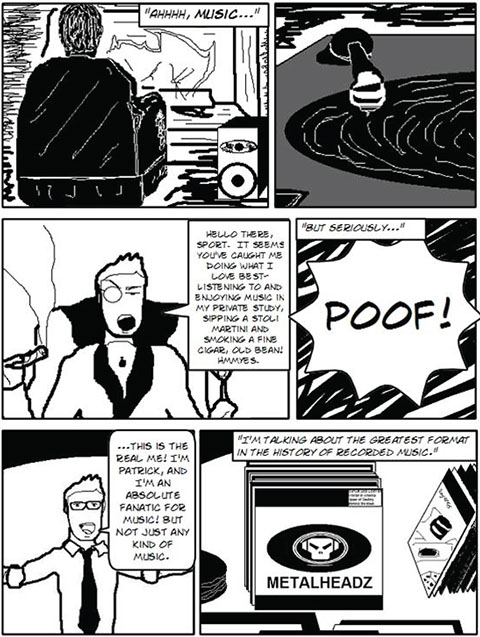
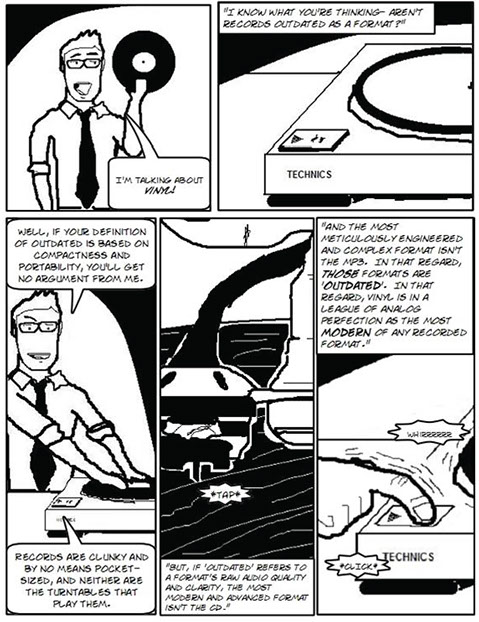
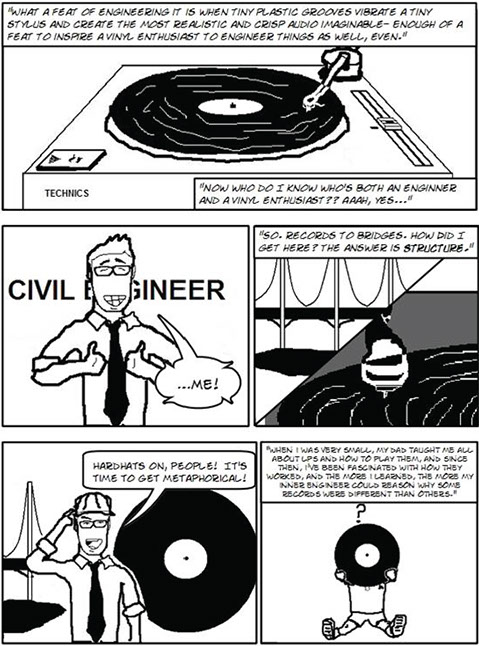
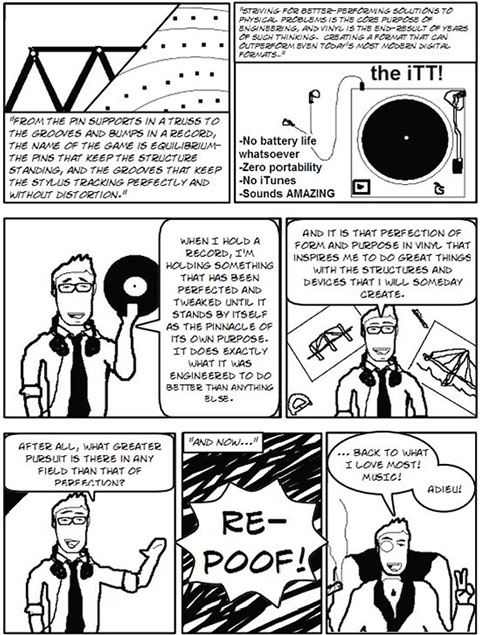
1 - 4
<
>
Student assignment by Patrick Brownson. Used with permission.
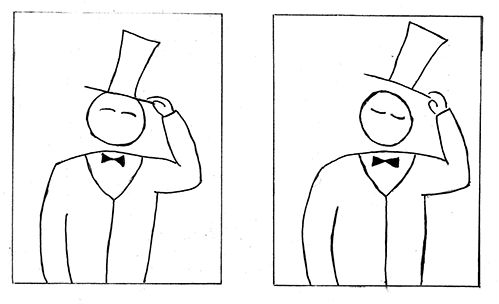
*Don't listen to him, it's Fort.
*There are problems inherent in the term reader when talking about comics. However, the etymological sense of gathering present across various languages describes the process of reading comics pretty well. Reading a comic entails collecting images, text, history, culture, and a variety of other things into provisional wholes. I stress the provisionality of interpretation because so many comic strips rely on encouraging one interpretation and then suddenly subverting that interpretation. We expect a joke, and so our initial interpretations are largely provisional. If they weren’t, we might be frustrated instead of amused.
Historical
Institutional
Non-Definition
Nope, it's Heraclitus.

